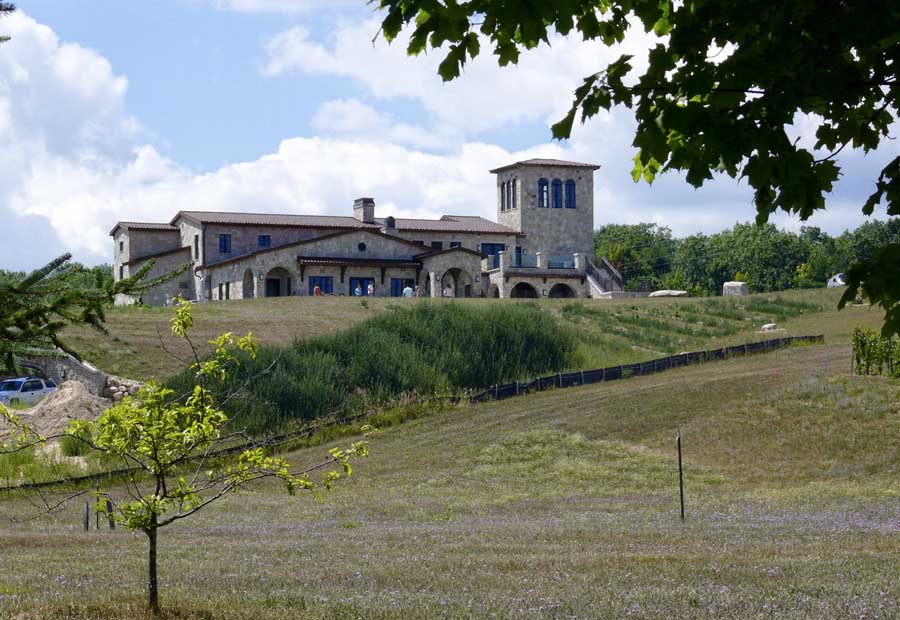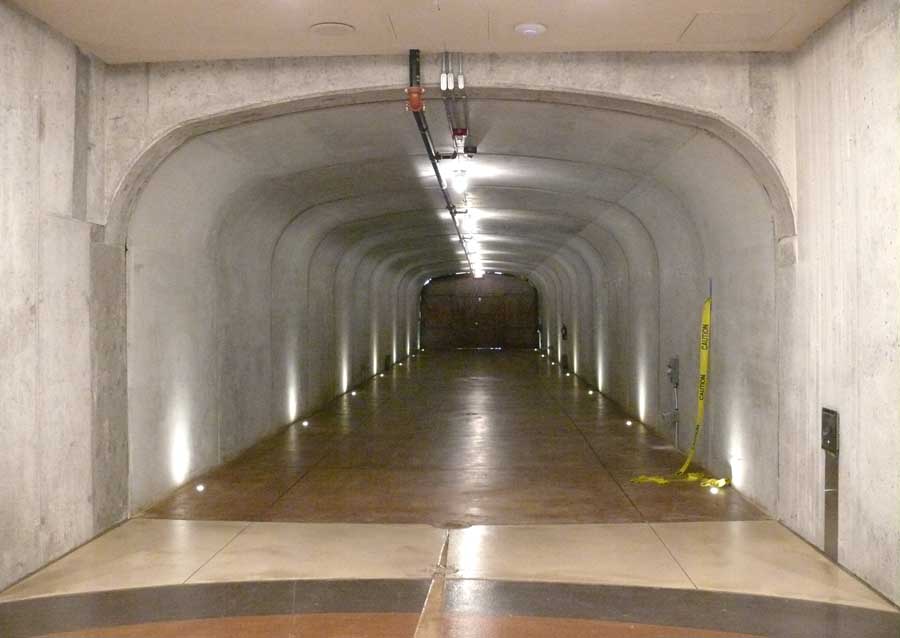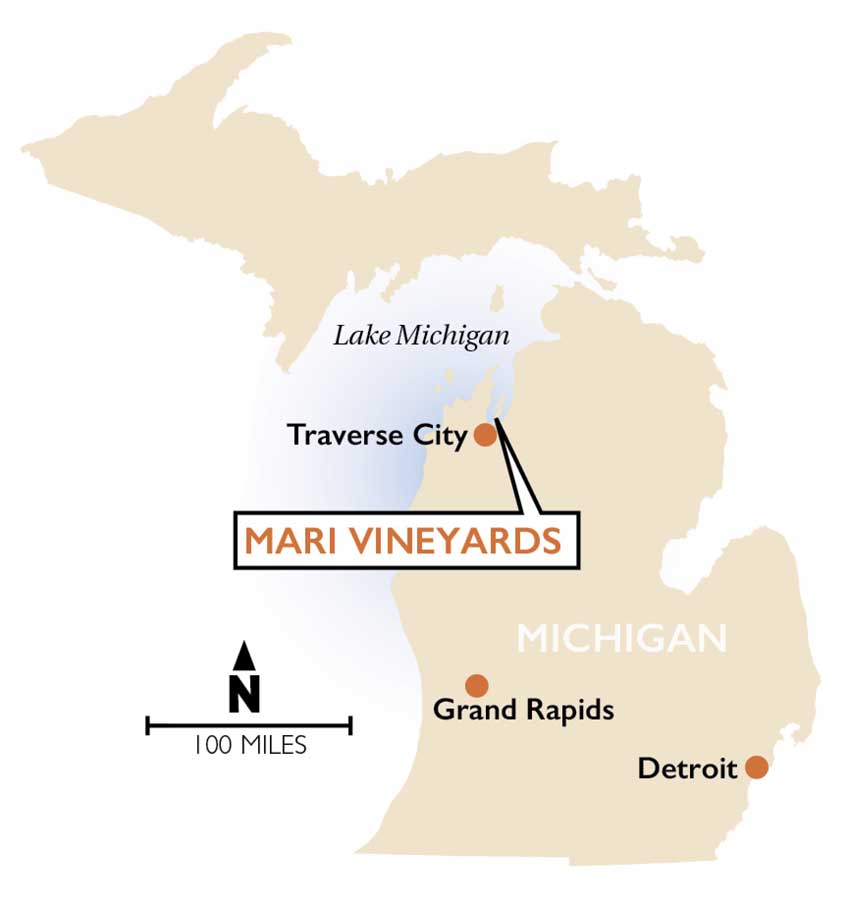
The stone Mediterranean-style villa beckons visitors to Mari Vineyards in northwest Lower Michigan. The winery officially opened for business in June. (By Leslie Mertz)
At the northern outpost of the Great Lakes wine-growing region, you anticipate occasional vineyards dotting the rolling landscape.
You don’t, however, expect to find Mari Vineyards and its grand, castle-like winery set on a hill overlooking Lake Michigan’s Grand Traverse Bay in the far northwestern reaches of Michigan’s Lower Peninsula.
The 40,000-square foot, stone winery features a large main-floor tasting room filled with polished ash tables, outdoor seating that overlooks the sparkling water of the bay, a state-of-the-art winemaking operation and an extensive cavern system for storing wines.
The winery opened for business in the spring of 2016, and when Good Fruit Grower visited this past August, the Mari Vineyards team was busy with final preparations below ground to receive its first harvest in the fall.
“These caves have been here going on a year now, and we’re still getting things ready,” said winemaker Sean O’Keefe. They are also continuing to add tasting rooms throughout the winery, including in the caverns, so they can host wine critics and “super-fans” of the wines.
“There’s just no winery in the Midwest with this level of investment,” O’Keefe said. He is familiar with pushing the envelope. After all, his father started Chateau Grand Traverse in 1974 as the first commercial winery in northern Michigan. “At the time, that was a pretty radical proposition and was considered a big deal, and now Mari Vineyards is the next big push or step up for the region.”
New grapes, new methods

Mari Vineyards’ constructed caverns were empty in August, but casks were on order in preparation for the fall 2016 winemaking season. The caverns, which extend up to 35 feet beneath the winery, are kept at a constant 53-degree temperature, ideal for storing both Mari’s white and red wines. (by Leslie Mertz)
Beyond the scale of the building and caverns, Mari Vineyards is also turning heads because of the Italian red-wine grapes it is cultivating — varieties such as Nebbiolo, Schioppettino, Cabernet Sauvignon, Syrah, Malbec and Sangiovese.
Owner Marty Lagina was intent on pursuing Italian varieties in homage to his grandmother who came from Istria in Croatia, which was once part of northeast Italy. Fortunately, the climate on the Old Mission Peninsula is moderated by the Great Lakes and expands the number of grape varieties vineyards can grow.
 However, climate only goes so far, so the winery gave its Italian grapes an additional nudge by adding high tunnels that cover about an eighth of their 56 acres. (Read more “High tunnels extend season”)
However, climate only goes so far, so the winery gave its Italian grapes an additional nudge by adding high tunnels that cover about an eighth of their 56 acres. (Read more “High tunnels extend season”)
About 12 feet tall at the center, each high tunnel covers three rows of grapes with heavy plastic sheeting set over an arched structure.
“The tunnels aren’t hermetically sealed, so we’re not separating the grapes from the environment, but they do let us tweak the temperature by 12 to 15 degrees or more and basically bumps us up by a climactic zone,” O’Keefe said.
The under-tunnel vines not only come out of dormancy earlier in the spring, but their grapes also have the time later in the year to ripen fully.
“That’s important because, while I can’t prove it scientifically, it seems like once the temperature drops down into the mid-30s at night during the final weeks of ripening, these red grape varieties won’t ripen efficiently even if the temperature rebounds back to the 50s the next day,” he said. Under the tunnels, however, they can continue ripening even into the first couple of weeks of November.
Mari Vineyards makes some premium wines completely with grapes grown under the high tunnels — including its Row 7 and Ultima Thule — as well as blends. “We’ve recently shifted to growing Refosco, Teroldego and some other varieties under the tunnels, as well as growing them normally outside. For instance, we might grow three rows or six rows under the tunnels, and use those grapes to blend at 5 to 25 percent,” he said. “That way, we give our wines a little more oomph, and especially in a colder year, we can guarantee we’re going to have a great-tasting wine.”
The pros of tunnels

Mari Vineyards is not only unique for its winery, but also for the varieties it grows. These include Nebbiolo, Schioppettino, Malbec and Sangiovese. High tunnels encourage these cultivars by extending the growing season by about a month. (by Leslie Mertz)
The extra ripening time is just one benefit of the high tunnels, said Sean Noell, vineyard manager.
Each tunnel covers three rows. Rain slides off the tunnel plastic, and although the tunnel manufacturer (Haygrove) offers a gutter system to collect that water, Noell prefers to let it seep into the ground at the edge of the two outer rows.
A drip-irrigation system feeds the central row and supplements the rain for the outer rows.
The tunnels also keep the between-row ground dry, which practically eliminates the need to mow.
In addition, Noell said, the below-tunnel aridity has been helpful in reducing mold and other diseases, and that drastically lessens the need for sprays and the costs associated with them. He has also seen that vines grown under the tunnels are healthier than those planted in the elements. “They are more vigorous and they get better carbohydrate storage, so they overwinter better.”
That’s not to say that the reduced need for irrigation and sprays negates the cost of the tunnels. “We still need to demand a premium for the grapes and the wine, but then again, we wouldn’t have nearly the consistency we get with our very ripe red grapes, and that improves the vintage,” Noell said.
Moving forward
Between the high tunnels, the wine-aging caverns, the new grape varieties in the vineyards and the sheer scope of the winery, Mari Vineyards has already made a mark in Michigan’s wine industry, but it’s not stopping there.
The winery is pursuing a “biopragmatic” program, which relies on low-impact sprays, such as sulphur, biological fungicides and phosphoric acid or Phostrol, that O’Keefe believes should be considered organic practices.
“I tried that at a previous winery, and it worked really well,” O’Keefe said. “With the high tunnels, where we don’t have the rainfall and other exposure to the elements, we might as well get all the benefits we can. I think we can easily go herbicide-free, and we’re starting to do some tweaking to figure out what we can do in that regard.”
To that end, Mari Vineyards is adding a clean ozone water treatment system. “With that, you basically spray ozonated water on the plants and it oxidizes the diseases and bugs. We are still building the system, and it’s kind of a risk because not many people have tried it yet, but our owner decided to give it a try because it would be chemical-free,” Noell said. “Stay tuned.”
In the meantime, the winery is taking every step it can to do the unthinkable: cultivate exceptional Italian grapes at the northern boundary of the Great Lakes wine region and turn them into bold reds, O’Keefe said.
“The tunnels allow us to consistently grow a few varieties that would otherwise only ripen a couple of years out of 10, and the caves allow us to make and store more wine than we need, so we can anticipate part of our terroir — that every 10 years or so, we’re going to have a brutal winter that will cut into the next year’s crop.”
Instead of pretending that it’s not going to happen, he said, “the tunnels and the caves are our way of preparing and, in a way, to make hay while the sun shines.” •
– by Leslie Mertz






Hi! Do you sell your wines anywhere in South Texas?